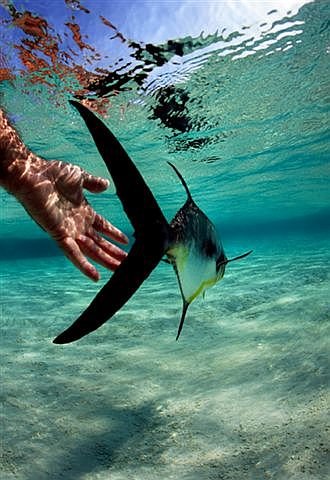Catch and Release Mortality in Belize
Documentation of Low Fish Mortality with Catch and Release Fishing at Turneffe Atoll
Catch and release refers to the concept of catching and then immediately releasing fish back to their natural environment. This concept dates back several centuries to early trout fishermen in England who developed this practice to maintain fish populations in their prized, local streams. Fishing legends and authors, Zane Grey and Lee Wulff, popularized the concept in the United States in the middle part of the 20th century.
Flats fisheries throughout the world have embraced catch and release as an important and effective fisheries management tool; and, over recent decades it has become an important conservation and environmental protection mechanism creating sustainable economic development opportunities globally. In 2009, Belize enacted landmark Catch & Release Legislation becoming the first country in the World to mandate that all bonefish, tarpon and permit be released.
Belize is known throughout the flats fishing world for its exceptional opportunities for the Grand Slam of flats fishing - bonefish, permit and tarpon. In 2007, Fedler, et al, determined that 92% of all sports fishers in Belize target these three species. Sport fishing is an important sector of Belize’s sustainable tourism economy, with catch and release playing an essential role. Fedler, et al determined that sport fishing supports 1800 full time jobs in Belize and generates US$56 million annually for the Belizean economy.
This study was repeated in 2013 by Bonefish Tarpon Trust who determined at that time that flats fishing in Belize for these species generated 112 million BZD annually. Considering the sustainable nature of Belize’s sport fishing, it could easily generate $1 Billion BZD for the Belizean Economy over the next decade.
Fisheries managers and conservation organizations have long debated the impacts of catch and release sport fishing on fish populations and considerable scientific is data available on this topic. Paul Riess, et al, summarized 82 studies analyzing catch and release mortality. Post-release mortality rates ranged from 0.2% to 5.8% with an average post-release mortality rate of 2.76%. Post-release mortality rates varied dramatically depending upon the species targeted, fishing techniques, the bait used and how fish were handled. Location of the hook wound is the single, most important factor with fish hooked in the esophagus or gills having high mortality rates; and fish hooked in the lip or jaw having very low mortality rates. It is, therefore, essential to evaluate individual fisheries based upon the tackle and techniques used in that fishery.
The preponderance of sport fishing in Belize is done by fly fishing enthusiasts using small artificial flies in active motion . Fishing operators encourage anglers to “pinch the barb” on hooks to further minimize impacts and anglers are also encouraged to land their fish as quickly as possible, handle them as little as possible and release them as quickly as possible to minimize fish exhaustion. These fishing techniques generally lead to fish being hooked in the lip or jaw with resultant low mortalities.
Catch & Release Mortality Analysis (Turneffe Atoll):
This analysis focuses on the sport fishing techniques and tackle widely utilized in Belize. It first looks at detailed data from well-known angler and author, Craig Mathews. Mathews collected catch and release data on bonefish over a 12 year period at Turneffe Atoll.
Bonefish Catch and Release Mortality Data: 1993 – 2010 (Craig Mathews)
Year Fish Landed Successfully Released Unsuccessfully Released
1993 (20 days) 115 113 2 Both taken by barracudas
1994 (20 days) 118 116 2 Both taken by barracudas
1995 (16 days) 120 120 0
1996 (20 days 174 174 0
1997 (19 days) 209 209 0
1998 (28 days) 341 341 0
1999 (12 days) 102 102 0
2000 (6 days 60 60 0
2002 (13 days) 62 62 0
2003 (9 days) 43 43 0
2009 (6 days) 45 45 0
2010 (4 days) 26 26 0
TOTALS 1415 1411 4
Percent Mortality 0.28 %
The majority of fishing guides who regularly fish Turneffe Atoll in 2011 were surveyed. Specifically, these guides were asked to recall the number of each species (bonefish, permit and tarpon) they witnessed expiring after being caught and released. In 2011, 11 guides recalled a total of 22 bonefish, 2 tarpon and 1 permit succumbing after release.
The following assumptions were made for this calculation: first, we assumed an average of 35 weeks per year worked per guide and an average of 6 fish landed per day. The great majority of fish not surviving, or 22 of the 25, were bonefish. Two tarpon could not be revived and one permit did not survive.
Estimated fish landed Estimated fish released unharmed Estimated fish unsuccessfully released
13,860 13,846 25
The majority of unsuccessful releases were related to bonefish taken by barracuda. Two tarpon, one permit and three bonefish could not be revived.
Percentage Witnessed Mortality = 0.18%
Results:
Craig Mathew’s recorded 1415 bonefish caught over 12 years with 4 dying after being released due to barracuda attacks presumably facilitated by these bonefish being temporarily weakened. This post-release mortality rate of 0.28% reflects the primary sport fishing species sought in Belize and also to the techniques and tackle utilized in Belize’s sport fishing industry.
Sport fishing guides who regularly fish Turneffe Atoll were interviewed and asked to recall the number of bonefish, permit and tarpon that they witnessed not surviving after being released in 2011. They noted 0.18% of released fish not surviving which correlates with Mr. Mathews findings.
Conclusions:
To be relevant, an analysis of catch and release sport fishing must accurately reflect the species targeted and the techniques utilized in that fishery. This analysis relates directly to the fish targeted by 92% of anglers in Belize and reflects the fishing tackle and techniques widely used.
Our analysis concludes that the mortality rate for catch and release fishing in Belize is low and correlates with the low end of the studies reviewed by Reiss et al. This supports the widely held view that catch and release sport fishing is an environmentally and economically sustainable tourism sector of Belize tourism economy.
Catch and release sport fishing has been the standard practice at Turneffe Atoll for three decades. Over this period, the health of Turneffe’s sport fishery has not only been sustained, it has improved. Sport fish stocks have increased as have average fish size. This would appear to substantiate that catch and release, as it is practiced in Belize, has successfully established a sustainable sport fishery.
References:
Dr. Anthony Fedler, Economic Impact of Recreational Fishing for Bonefish, Permit and Tarpon in Belize for 2007.
Records obtained from Craig Mathew, West Yellowstone, MT
Government of Belize: Statutory Instrument No. 114 of 2009, Fisheries (Species Designation and Protection Regulations, 2009
P. Reiss, M. Reiss, J. Reiss, Phd, J. Reiss, BS: Catch and Release Fishing Effectiveness and Mortality. [http://www.acuteangling.com/Reference/C&RObserve.html#moreinfo] Accessed on March 4, 2012.


